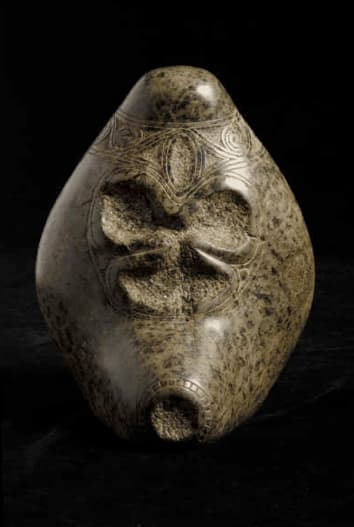Taino Stone Trigonolitos Depicting a Skull, 1000 CE - 1500 CE
Stone
9 x 8.5
LO.1320
This Taino three-pointer or ‘trigonolitos’ is incredibly rare and unusual in terms of its design. These triangular carved stones were unique to the people of the Caribbean, and have a...
This Taino three-pointer or ‘trigonolitos’ is incredibly rare and unusual in terms of its design. These triangular carved stones were unique to the people of the Caribbean, and have a long history that predates the Taino efflorescence, c. 1200-1500. Plain, undecorated examples have been dated as early as c.400-200 BC. ‘Taino’ is the term applied to a group of agricultural communities, ruled by hereditary chieftains (caciques). Culturally they were the most sophisticated people of the Caribbean until their way of life was tragically destroyed by the Spanish settlers at the end of the fifteenth century. Although they left no written records, a wide range of physical artifacts survive and testify to extremely high standards of craftsmanship. These skills were utilized in the service of religion and images of Taino gods and spirits (zemis) were carved in wood, shell, bone and stone. The majority of the three-pointers depict a skull-like face or a recognizably zoomorphic form. In contrast this example is far more abstract and iconographically intriguing.
The artist was clearly spellbound by his/her material, and the dark green stone, flecked with black, has been highly polished. The majority of the surface is unadorned but a deeply carved geometric motif enlivens one side. The surface of the stone within this design has been deliberately left with a coarser surface, resulting in an effective contrast of textures. The almost clover-shaped motif may well represent a stylized animal, especially when viewed in conjunction with the lightly incised oval above. This forms part of a band of geometric motifs that runs around the top part of the central point. The symbolism of this cone shape has been hotly debated, with suggestions ranging from the manioc shoot (the main Taino crop) to the human breast. Some association with power and/or fertility seems likely and is confirmed by the testimony of Columbus himself, ‘Equally the majority of caciques (chiefs) have three stones to which they and their people have great devotion. One they say is for the fertility of the grain and vegetables that they grow; the next for mothers to give birth without pain, and the third for the water and sun when they have need.’ Although their precise function remains a mystery, these ritual objects still astound us with their abstract form and bold design. The rarity of this particular motif will be of especial interest to any serious collector in this fascinating field. (AM)
The artist was clearly spellbound by his/her material, and the dark green stone, flecked with black, has been highly polished. The majority of the surface is unadorned but a deeply carved geometric motif enlivens one side. The surface of the stone within this design has been deliberately left with a coarser surface, resulting in an effective contrast of textures. The almost clover-shaped motif may well represent a stylized animal, especially when viewed in conjunction with the lightly incised oval above. This forms part of a band of geometric motifs that runs around the top part of the central point. The symbolism of this cone shape has been hotly debated, with suggestions ranging from the manioc shoot (the main Taino crop) to the human breast. Some association with power and/or fertility seems likely and is confirmed by the testimony of Columbus himself, ‘Equally the majority of caciques (chiefs) have three stones to which they and their people have great devotion. One they say is for the fertility of the grain and vegetables that they grow; the next for mothers to give birth without pain, and the third for the water and sun when they have need.’ Although their precise function remains a mystery, these ritual objects still astound us with their abstract form and bold design. The rarity of this particular motif will be of especial interest to any serious collector in this fascinating field. (AM)



